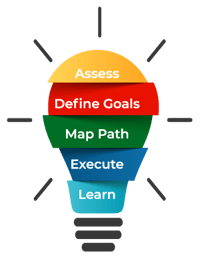Coined by Gartner in 2019, the term xP&A stands for Extended Planning and Analysis. Often touted as a rebranded and overhyped version of Integrated Business Planning by many pundits, Gartner claims xP&A is much more than just that. In this article we will offer arguments to support this contention.
rebranded and overhyped version of Integrated Business Planning by many pundits, Gartner claims xP&A is much more than just that. In this article we will offer arguments to support this contention.
WHAT IS xP&A?
xP&A aims to not just break down the traditional boundaries between the operations, sales, and financial planning silos but also to extend the best FP&A (Financial Planning & Analysis) technology platforms to the rest of the organization to create a more cohesive and granular approach to data flows within all planning and forecasting activities in the enterprise. Capabilities such as continuous planning, rolling forecasts, advanced analytics, and performance monitoring of key performance indicators (KPIs) can be extended to the entire enterprise with xP&A allowing greater participation from departments beyond finance and producing actionable real-time feedback to drive better decisions.
In short, xP&A helps businesses go beyond the limitations of spreadsheets, harnessing AI (Artificial Intelligence) and data-centric planning to produce agile, accurate, and adaptable plans and forecasts.
Some of the most common applications of xP&A are financial planning, workforce planning, capital expenditure planning, balance sheet, and cash flow planning, demand planning, revenue planning, predictive planning, and capacity planning. xP&A can be extended to all operational and strategic departments of the enterprise to reduce friction between silos and speed up planning cycles.
THE APAC AND XP&A
Recently, the Asia Pacific FP&A Advisory Council (APAC) took up a discussion on this topic and endorsed the fact that xP&A is an evolved version of FP&A that builds on current trends, frees finance from data drudgery, and makes the CFO and FP&A team more valuable. They also talked about how xP&A uses automation and distributed data entry to speed up the forecasting process.
But they also listed some concerns that put a question mark on the overall implications of xP&A.
IS xP&A THE SAME AS INTEGRATED PLANNING?
The first concern was that xP&A is nothing but a fancier term for integrated planning, an idea that has been around for a very long time. While this statement is partially true - xP&A is indeed an advanced version of Integrated and collaborative planning - richer data availability and the commoditization of AI have opened new paths to bring the vision closer to reality. Integrated planning has always been a desirable idea, but the ability to execute was limited by the one-two punch of siloed business processes and technical constraints.
xP&A encompasses both the goal of increasing efficiency while reducing bias through integrated planning, as well as the means of achieving the goal. Over the last ten years the growth of cloud computing and commensurate drops in data storage costs has made it possible to capture and store data at greater levels of granularity. This in turn has enabled the spread of AI and Machine Learning across all functions in companies, including for planning and forecasting use-cases.
With ready access to affordable technology that supports collaborative planning, companies are finding it easier (though not easy!) to break down their siloed business processes and realize the bottom-line benefits that accrue from truly collaborative integrated planning and forecasting.
Before xP&A, integrated planning practices struggled to take hold in most enterprise settings. Most companies either failed to implement the idea effectively or simply refused to commit financially to this bold step. They saw no reason to overhaul their business processes and invest in a brand-new idea that hadn't been tested yet.
And then the COVID_19 pandemic happened.
IMPACT OF THE PANDEMIC ON xP&A
The 2020 pandemic dramatically altered operations at many businesses. Supply chains were disrupted, workforces limited, and forecasts negated. The pandemic highlighted the need of each business for an accelerated and automated system that could integrate planning across operations, sales, and finance. What was needed was something adaptable, agile, and responsive. This is where xP&A came in.
Gartner released a report in 2020 that predicted that 70% of all new FP&A projects will become xP&A projects by 2024. The report also mentioned that 50% of new FP&A implementations will be done in partnership with vendors who offer a higher degree of integration and product bundling. At QueBIT, we have witnessed the evolution in responses towards integrated planning first-hand. Back in 2018, organizations weren't as willing to engage in conversations about xP&A or to invest as they are now.
xP&A IMPLEMENTATION - COMBINING TECHNOLOGY WITH BUSINESS PROCESSES
The APAC also debated whether xP&A might not be anything more than a utopian vision being peddled by opportunistic consultants and software companies. This suspicion came from anecdotal evidence that some companies had ostensibly deployed “xP&A systems” without seeing the promised returns.
Where most companies fail while using xP&A, is when they focus solely on the software part of it. There is a misguided belief that switching to the right technology platform alone will usher in the digital transformation required to succeed with xP&A. They couldn't be more wrong. The full potential of xP&A can only be realized if the technology is combined with a redesign of business processes. This

overhaul requires active participation from the top executives of all the involved departments. Issues such as data granularity, timing, and reporting points of view also need to be ironed out. Without engagement from all departments, the xP&A system will fail to achieve the desired results.
CONCLUSION
With QueBIT’s 5-step outcome-focused methodology, which assesses problems, defines goals, maps the customer success plan, and executes the solution, you can ensure that your business establishes a strong technical foundation for xP&A to get proven and measurable incremental benefits over time.